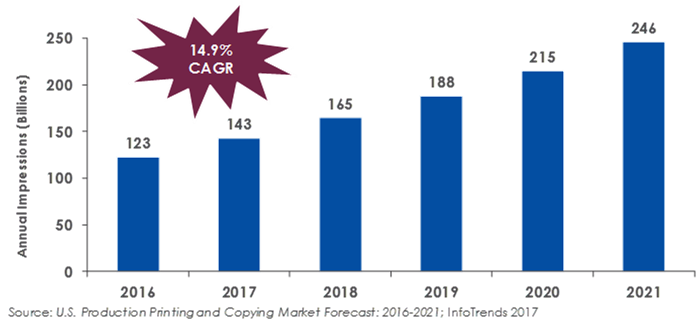This article originally appeared in the March/April, 2018 issue of Mailing Systems Technology.
Innovations in high-speed inkjet printing are expanding the role of statements and transactional documents in delivering marketing messages. Transactional messaging is a native personalized customer communication. Each bill, statement, invoice, check, or explanation of benefits is already designed with content unique to its recipient. Today, savvy organizations are seeking better ways to leverage the natural advantage of printed transactional communications.
The commercialization and implementation of inkjet printing is enabling the production of affordable full-color work and personalization with faster turnaround times. Moving forward, ongoing innovations in inkjet will drive substantial growth in digital page volumes. InfoTrends estimates that inkjet devices produced more than 122 billion impressions in the United States in 2016, and that number is predicted to reach 246 billion impressions by 2021 — a 14.9% compound annual growth rate (CAGR) (Figure 1).
Figure 1: U.S. Annual Inkjet Impressions: 2016-2021

InfoTrends’ most recent US Application Forecast projects that an increase in online access for bills and statements will drive down overall page volume. While overall page count is expected to decline, the number of pages per bill/statement will increase as businesses work with print service providers to deliver more information on each bill. In a similar way, although overall transactional pages are declining, those with marketing messages are on the rise. The combination of more (and better) consumer data, the drive for personalization, and the increasing affordability of inkjet are all enhancing the marketing role of transactional documents.
Enhanced workflow solutions and the affordability of digital color inkjet technology are also accelerating the use of color in basic bill/statement printing. Color has proven critical in business communications with its use increasing brand recognition and boosting response rates. By uniting customer-specific data with full-color personalized messages, bills, statements, and purchase orders can be transformed into attention-grabbing marketing tools that reinforce branding and create a dialogue with customers to cross-sell and up-sell products and services.
Printed transactional communications have not lost their luster. According to the USPS, in 2016, US households received more than 26.3 billion bills and statements in the mail. Despite banks, credit card companies, and other businesses aggressively pushing their customers to “go paperless,” consumers still value and demand physical documents, and they are beginning to push back.
InfoTrends’ 2017 Annual State of Transactional Communications study found that over 88% of the 2,000 consumers surveyed still receive paper versions of their transactional communications. Their top reasons for retaining paper statements include:
- Wanting a hard copy for records (47%)
- Paper statements serve as a reminder to pay (37%)
- Paper statements are a security precaution (23%)
In addition, InfoTrends’ consumer research studies offer key insights into ways organizations can enhance printed communications. Recipients of transactional communications advise statement senders to:
- Make communications relevant to the recipient
- Make them easier to understand and personalize the content
- Put multiple communications in a single envelope
- Use color to emphasize important information
Knowing your clients’ customers and adjusting your approach to meet their needs and accommodate their communication preferences is essential to winning work. There are a growing number of communication channels, but print remains an important pipeline to consumers of all ages. Transactional documents are delivered to customers every day — enriching them with marketing content makes good business sense in a market where consumers are demanding colorful, data-rich, personalized communications.
High-speed inkjet and full-color communications provide value to customers and service providers. Continued success depends on delivering enhanced communications through affordable digital color and its associated improvements in response rates, time-to-market, and cost.
Lisa Cross, Associate Director of InfoTrends’ Business Development Strategies Consulting Service, is responsible for conducting market research, managing consulting projects, and assisting companies in developing multi-channel communication, marketing, and content strategies.
Click here to return to the Document production and printing topic page.













